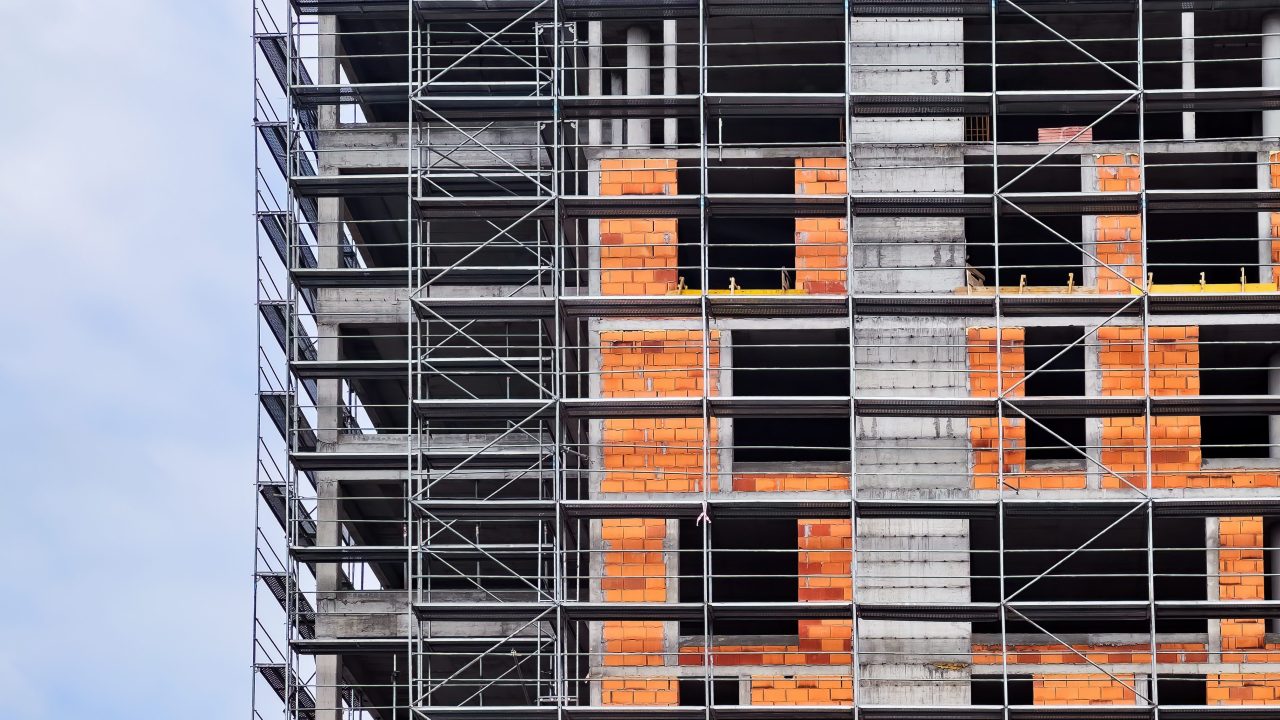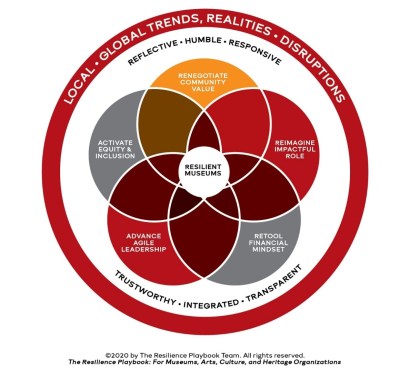
This article originally appeared in the May/June 2021 issue of Museum magazine, a benefit of AAM membership.
“For museums, the choice is either resilience or irrelevance. When museums see themselves not only as serving their community but as their community, they will undoubtedly be resolute, fortitudinous, adaptive, and unrelenting despite the challenges they face.”
Extraordinary times demand that museums rethink and reposition themselves to be more integral and valued members of their communities. As the pandemic unfolded, societal inequities intensified and revealed structural, philosophical, and ethical weaknesses within museums and cultural organizations. Additionally, it became clear that government agencies and the general public did not view museums as essential players contributing to the vitality of community life.
These stark realities necessitate new approaches to address the loss of public participation, diminished financial resources, and racial inequities, and systemic exclusionary practices in museum workplaces, boardrooms, collections, and programming. Further, climate change and environmental injustices, agile digital strategies, flexible internal operations, and healthy community partnerships are but a few of the realities museums need to acknowledge and address. Unfortunately, many museums are still operating with inflexible mindsets, outdated assumptions and practices, and long-standing traditions that have been immune to critical examination.
This is an opportunity to “go down to the studs,” tackle embedded assumptions and reimagine museums as integral to public vitality and the greater ecosystem of which they are a part. To do so, institutions must rethink holistically—inside out and outside in—and re-envision what they are and what they can be.
Resilience positions museums to nurture more flexible and responsive operating models for a world where disruptions will continue and social and environmental issues will persist. Are museums part of the solution? We believe they are, but we also know that meeting this moment will require more than a pivot; museums will need to undergo transformational change.
The Resilience Model
What do we mean by resilience? Most definitions of resilience focus on the ability of an organization to bounce back from adversity. Resilience is much more than reacting to events thrust upon us or those of our own making; resilience is about anticipating disruption and generating an array of responses to flourish in the face of change.
 Without a strong, strategic foundation from which to grow resilience, institutions are vulnerable to ongoing disruptions. The process of reframing, realigning, and reinventing any museum’s understanding of its work first requires analysis and ownership of its institutional history and current practices. When organizations are able to do this, they harness the awareness needed to build resilient mindsets, values, skills, and relationships that elevate their value in a rapidly evolving world.
Without a strong, strategic foundation from which to grow resilience, institutions are vulnerable to ongoing disruptions. The process of reframing, realigning, and reinventing any museum’s understanding of its work first requires analysis and ownership of its institutional history and current practices. When organizations are able to do this, they harness the awareness needed to build resilient mindsets, values, skills, and relationships that elevate their value in a rapidly evolving world.
The Resilience Model highlights five resilience goals forming a system of tightly interrelated operational components that are the lifeblood of agile, responsive organizations. Immediately surrounding the goals in the diagram at right are six resilient characteristics that institutions must embrace in order to effectively address the constantly changing external realities of the local and global environments in which they operate. The Resilience Model, featured in the resource The Resilience Playbook, outlines five goals, each supported by four plays, that capture a series of actions for museums to undertake the work of becoming resilient. This unprecedented opportunity is the moment to reimagine museum relevancy moving forward.
The Resilience Model is a holistic approach to institutional transformation that addresses the changes needed to establish museum resiliency. It is built on:
- tackling embedded racial inequities and colonial and exclusionary practices to achieve greater resiliency;
- examining all institutional assumptions to reveal inherent strengths and vulnerabilities and identify the re-envisioning and rebuilding needed;
- participating in resilience work at the board, executive leadership, staff, and volunteer levels while engaging communities and stakeholders;
- listening with humility, learning, and co-creating solutions internally and externally;
- re-envisioning a resilient institution not as an isolated effort but an integrated way of being for the greater good; and
- remembering transformational work is a long-term commitment of revitalization where short-term benchmarks create momentum.
The Five Resilience Goals
Goal 1. Activate Equity and Inclusion
Resilient organizations need to move past intention and into action. Resilience is about mindsets and being ever-flexible. “Activate Equity and Inclusion” is Goal 1 because it is central to the success of an institution’s internal and external relationships and current and future resilient decision-making. Equity and inclusion reflect a complex and expansive ideology to be embraced throughout the organization and with their communities.
In the US, in particular, there is an imperative to address racial inequities; however, all diversity, equity, accessibility, and inclusion work is embraced within this goal. Equity and inclusion efforts require both individual (personal) and institution-wide work.
Commit to Resilience: Center equity and inclusion in all of your decision-making.
- Reflect on and acknowledge the organization’s current status in relation to equity and inclusion, including a focus on gaps and opportunities.
- Develop shared language and shared understanding about the power of diversity, equity, access, inclusion, and anti-racism as the foundation for current and future initiatives.
- Develop specific, measurable, attainable, relevant, and time-bound actions that will lead to greater equity and inclusion across the organization.
- Make equity and inclusion the work of the entire organization at all levels now and into the future.
Goal 2. Renegotiate Community Value
The realization that museums were not considered essential at the outset of COVID-19 laid bare that museums have a lot of work to do to earn community respect. Effective community engagement is a long-term commitment based on listening to communities and co-creating strategies that strengthen community vitality. Further, this goal is about shifting the role of the museum from being a destination toward being a fully integrated community partner that actively affirms that collective problems, such as socioeconomic inequities, climate change, and educational systems in crisis, require collective solutions. Museums cannot stand on the sidelines expecting others to address these persistent and urgent issues; museums must do their part.
Commit to Resilience: Redefine the organization as integral, relevant, and vital to public life.
- Integrate shifting external realities and needs locally and globally as part of staying current and relevant.
- Identify opportunities where the organization can be a key player in the community ecosystem and larger world.
- Leverage institutional capacity, offerings, collections, and facilities to make a meaningful difference to communities.
- Build strategies, relationships, and partnerships to expand the museum’s impact.
Goal 3. Reimagine Impactful Role
This goal advances resilience by asking institutions to challenge their assumptions about how their pasts continue to influence current operations for good or ill. Confronting, naming, and owning exclusionary practices and colonial roots is essential internal work: no museum can achieve true resiliency without addressing the evidence and nature of past decisions, harms caused, and the embedded practices that may have left many without a voice or representation.
While part of this goal is about decolonizing the museum, it is also about addressing institutional priorities, practices, and processes that reveal realities about authority and power, diverse approaches to working with the public, and collection equity and access. Understandably, this process of deep assessment will lead to repositioning the museum’s purpose, mission, and institutional commitments.
Commit to Resilience: Reinvent the organization for the greatest relevance.
- Address the organization’s historical origins in order to rectify past practices that excluded, misrepresented, or disrespected the rights and identities of people, cultures, and traditions.
- Redefine principles to strengthen connections with communities and the public to support relevant, meaningful, and inclusive practices.
- Revitalize the strategic framework with a relevant mission, an inspirational vision, core values, and an institutional commitment to equity, inclusion, and anti-racism supported by policies and practices that champion positive, sustainable change throughout the organization.
- Commit to agility and resilience as external trends and issues prompt shifts, further refinements, and responses over time.
Goal 4. Retool Financial Mindset
This goal underpins the essential need for financial strategies to support the work of transformation, building financial resilience, and instilling the ability to be flexible and prepared. Understanding the connections between financial resources and the institution’s internal and external realities is about aligning institutional convictions with the resources required to address them.
Critical examination of the museum’s business model once again challenges assumptions and assesses where and how every resource is secured and invested, thus catalyzing new decision-making criteria and processes and laying the groundwork for rigorous resilient practices. Instilling institution-wide financial literacy gives board and staff members an understanding of, and respect for, the intricacies of running a museum’s complex operation.
Commit to Resilience: Build financial resilience.
- Build financial rigor and minimize vulnerabilities through informed actions.
- Strengthen financial literacy among all staff and board members.
- Align financial and physical resources to support the organization’s mission, vision, values, and equity and inclusion commitments.
- Develop a financial road map with tools and metrics that deliver on anti-racism and inclusion, community value, impactful role, and leadership.
Goal 5. Advance Agile Leadership
The final Playbook goal speaks to our understanding that institutional reframing, realigning, and reinvention are unlikely to occur without organizational leaders (including staff leaders) who are receptive to making change. Change requires a sense of urgency and champions for change combined with an integrated and inclusive approach to examining organizational culture and structures. That means unlearning old behaviors in order to pursue a new clarity of purpose rooted in a “values first” approach.
Museums must re-examine board and staff roles and responsibilities and their policies and procedures in order to ensure agility. Accept that no individual has all the answers, especially when it comes to complicated crises like COVID-19 and systemic racism. Resilient leaders use diverse teams to help them problem-solve, and, in doing so, they foster learning environments.
Commit to Resilience: Recalibrate leadership for peak performance.
- Create a leadership model that is holistic, integrated, and inclusive.
- Co-create a value-driven organizational culture that informs how work is done at the staff, board, and volunteer levels.
- Reconfigure your organizational structure to achieve greatest impact.
- Build a learning organization that is responsive and agile.
Many conversations, actions, and decisions will occur before organizations are authentically equitable, inclusive, resilient, and active participants in their communities. While each institution will envision its own path into the future, all must address past and current practices before moving forward.
The Resilience Model requires intentionality, diligence, courage, patience, and, above all else, an institutional commitment to do the work and accept the need for change. In the end, we hope the Resilience Model and The Resilience Playbook generate deep self-reflective conversations in the field, leading to meaningful changes and a growing community of resilient museums.
Anne W. Ackerson is an independent consultant, Gail Anderson is president of Gail Anderson & Associates, and Dina A. Bailey is CEO of Mountain Top Vision. They are the developers and authors of The Resilience Playbook.







